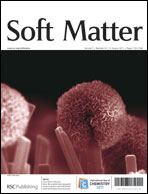Highly branched poly(N-isopropylacrylamide) (PNIPAM) was first synthesized by self-condensing atom transfer radical copolymerization (SCATRCP) catalyzed by CuBr/tris[2-(dimethylamino)ethyl]amine (Me6TREN) complex in isopropanol at room temperature. This method showed good control over chain morphology and lower critical solution temperature (LCST) type phase transition behavior of PNIPAM by varying reaction time and monomer/inimer feed ratios. On the basis of GPC, FTIR, 1HNMR and DSC results, four stages were discerned during the polymerization procedure, at which chain architectures experienced “linear – comblike – slightly branched – highly branched” transformations. Additionally, the synthesized highly branched PNIPAM chains were found to be able to self-assemble into hollow spheres in alcohols such as methanol and ethanol, which arise from the presence of large amounts of hydrophobic branched points inside polymer chains.
You have access to this article
 Please wait while we load your content...
Something went wrong. Try again?
Please wait while we load your content...
Something went wrong. Try again?


 Please wait while we load your content...
Please wait while we load your content...